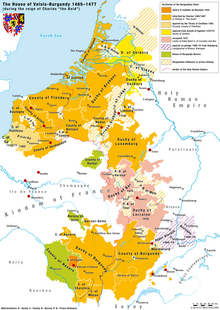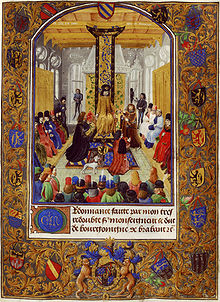Charles the Bold
A shy and pliant young woman, Isabella was adored by Philip the Good, who saw an opportunity to renew the Treaty of Arras (which had been debased by Charles VII's threatening actions towards Burgundy) by marrying a Bourbon to his son.The Duke, wary of the power his chancellor might get with this appointment, refused his son's request and instead proposed Philip I of Porcéan, high bailiff of Hainault and a member of the influential House of Croÿ.[60] While the duke thought that the hostilities between France and Burgundy were at an end, the new king at his coronation ceremony refused to participate in the feast sponsored by Philip in his honour.[61] Charles feared Louis's intention was to demolish the Burgundian defensive system in Picardy, and he was furious when a crisis occurred in autumn 1463 regarding the Somme towns, land belonging to his father.[65] The League became the most dangerous in a series of princely revolts against the French crown; one chronicle recorded the number of the participants against Louis XI to be seven dukes, twelve counts, two lords, one marshal, and 51,000 men-at-arms.[67] The parties signed the Treaty of Conflans, which ceded the rule of Normandy to Charles, Duke of Berry, and returned the Somme lands to Burgundy.The Estates of Guelders, and the towns of Nijmegen, Arnhem, and Zutphen rejected Arnold's will, and Louis XI asked Frederick III, the Holy Roman Empire, to confiscate the duchy.[112] Charles greatly desired to transform the Duchy of Burgundy into a kingdom, to free it from the limitations of vassalage to the French crown and to enhance his personal stature.[113][e] Despite all the grandeur, Frederick III was disappointed that Charles had not brought his daughter,[119] amidst rumours spread by Habsburg adversaries alleging that Mary was physically defective.[136] To both increase his grip on the seats of justice and to fill up his treasury, Charles dismissed the aldermen and sold their offices to the highest bidders; only the wealthiest subjects came to hold those positions.According to Nancy Bradley Warren, the portrayal of Charles and Saint Anne may have been a way to legitimise his marriage to Margaret and reassure those who were dubious regarding an alliance with England.[146] Pope Sixtus IV sent three instructions to the papal legate at the Burgundian court, Lucas de Tollentis, directing him to encourage Charles to undertake a crusade against the Ottomans.[148] Charles may have considered an expedition to the east as the climax of his life's work; however, during his lifetime, he never undertook a crusade nor did he make preparations for it as his father had.[149] Only for a short time, between late 1475 and early 1476, did he seriously consider a crusade and that was only after a meeting with Andreas Palaiologos, the deposed Despot of the Morea, who agreed to cede his claim as the Emperor of Trebizond and Constantinople to Charles.[155] However, the mutual friendship with the Kingdom of Naples brought Burgundy and Hungary closer to each other, and in his pursuit to ally with Frederick III's opponents, Charles made contact with Matthias.[172] Charles constantly toyed with the idea of marrying his daughter, Mary, to Ferdinand's second son, Frederick of Naples, who visited the Burgundian court in 1469 and 1470.Charles the Bold triumphantly replaced Louis XI as the dominant influence in Italian politics, with three of four major secular powers in the region—Milan, Naples, and Venice—all aligned with him.[197] As a patron of Renaissance humanism, he commissioned the translation of Quintus Curtius Rufus's Histories of Alexander the Great into French to replace the inadequate Roman d'Alexandre en prose.[205] Charles was a patron of the composer Antoine Busnois, who became his choirmaster;[206] his court musicians also included Hayne van Ghizeghem and Robert Morton.[215] The first of these ordinances, addressed to the Marshal of Burgundy, contains instructions on who could be recruited to the army and describes the personnel of the artillery: namely, masons, assistants, cannoneers, and carpenters.[216] The second ordinance, issued at Abbeville in 1471, proclaimed the formation of a standing army, called Compagnie d'ordonnance, made up of 1250 lances fournies, who were accompanied by 1200 crossbows, 1250 handgunners, and 1250 pikemen.[230] Despite the constant warning from military authors of the past against the recruitment of mercenaries, contemporary chronicler Jean Molinet praised Charles for his brilliant solution, saying that he was favoured by both heaven and earth and thus above the "commandments of philosophers".[231] Over the span of five years, Charle's deputy in Upper Alsace, Peter von Hagenbach, alienated his Alsatian subjects; antagonized the neighbouring Swiss Confederacy, who felt threatened by his rule; and showed aggressive intentions towards the city of Mulhouse.[233] In April 1474, the rebelling Alsatian cities and the Swiss formed the League of Constance to drive Charles and Peter von Hagenbach from Alsace,[235] and rebellion quickly broke out.[244] Upon learning of Frederick's plan, Charles intensified the barrage, and attempted to drain the city's moat by diverting the River Erft and sinking overloaded barges into the Rhine.[250] Charles had to sign a treaty with Louis as well, so that he would be free to march south and deal with the League of Constance, whose members now also included René II of Lorraine.[273] Charles was too slow in organizing his troops for a counterattack: he himself tarried in putting on his armour, and before his men finished taking their positions, the Swiss army had already reached them.[291] It took a group consisting of Charles's Roman valet, his Portuguese personal physician, his chaplain, Olivier de la Marche, and two of his bastard brothers to identify the corpse through a missing tooth, ingrown toenail, and long fingernails.To secure her legitimacy as ruler, Mary signed the Great Privilege on 11 February 1477 and restored powers to the States General in Flanders, Brabant, Hainaut, and Holland.[296] Maximilian used a combination of diplomacy and military strength to defend and regain territories from Louis XI, though France kept the geographic Duchy of Burgundy; he also quelled several internal revolts to preserve a great deal of the Burgundian State.





















Charles the BaldOrder of the Golden FleeceRogier van der WeydenDuke of BurgundyPhilip the GoodMary the RichBurgundyLorraineChurch of Our Lady, BrugesCatherine of FranceIsabella of BourbonMargaret of YorkValois-BurgundyIsabella of PortugalRoman CatholicismHouse of Valois-BurgundyKing Louis XIFranceWar of the Public WealNorth SeaGueldersUpper AlsaceKing of the RomansGermansMaximilian of Austriailluminated manuscriptsSaint GeorgeVenetiansOttoman TurksBurgundian WarsLower Leagueunsuccessful siege of NeussGrandsonBattle of NancyRené II of LorraineWar of the Burgundian SuccessionBurgundian StatePhilip of AustriaBurgundian NetherlandsPhilip the BoldJohn IIKing of FranceMargaret of MaleLouis II, Count of FlandersFlandersRethelAntwerpMechelenArtoisFranche-ComtéNeversLow CountriesCharles VCharles VIAnthonyPhilipLouis of Orleansassassination of LouisArmagnac–Burgundian Civil WarMichelle of ValoisBonne of ArtoisPéronnePicardyHoly Roman EmpireJean IIIHainautHollandFrieslandZeelandJacqueline, Countess of HainautPhilip of Saint PolDuchy of BrabantprincipalitiesLimburgLotharingiaSigismundCongress of ArrasDuchy of BurgundyBlessed Sacramentknight of the Golden FleeceCharolaisknightly orderCharles of NeversAntoinede CroÿSophie FrémietTalantplagueBrugesUniversity of LouvainAlexander the GreatAgnes of ClevesMary of BurgundyJohn the FearlessCharles VIICatherineSaint-OmergovernessseigneurAuxi-le-ChâteauchamberlainJean Wauquelin presenting his 'Chroniques de Hainaut' to Philip the GoodrebelledBattle of GavereburghersAgnes of BurgundyCharles I, Duke of BourbonChinonImperial DietRegensburgEmperor Frederick IIIhis aspirations for a crusadeConstantinopleOttomansAymeriesNicolas RolinPhilip I of Porcéanhigh bailiffHainaultHouse of CroÿDendermondeSoigniesJean ChevrotLe QuesnoyBlue TowerGorinchem